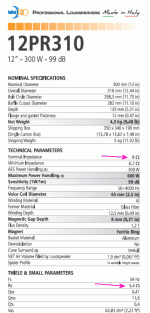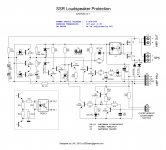Thanks LKA...
I guess this circuit could be driven by ANY independent pwr supply right ?
As long as speaker connections are done, it would be fine.
The reason I am asking is, I have an amp that runs on +/- 85 volts (about 500w rms/8 ohms per channel). I was thinking of having a small independent supply just to drive this circuit.
You could use independent power supply, but D7/D8 must be connected to main power supply. I designed this circuit for my AIO amp, for independent PSU I would use a bit different approach.
For 80-90V PSU use 200-250V mosfets (Rdson<10mR) and probably heatsink for them.
I have a doubt about it that the mosfets are rated at 120Amps now consider the pins of the mosfet upto what current ratings will those pins work without any issues? I mean the die of the mosfet might be able to deliver instantaneous or pulse currents of 120A but when it comes to sinusoidal waves what will be its capacity even though Vds is lower like about 3V or 4V max so when we check the SOA the device is capable of delivering the current but will the pins be able to deliver the current?
are you able to drive amplifier like +/-85V 500W into 4 ohms endup approx worse case current about 25Amp at an instance so will the pins be able to carry soo much of current?
are you able to drive amplifier like +/-85V 500W into 4 ohms endup approx worse case current about 25Amp at an instance so will the pins be able to carry soo much of current?
I think that i have to speak to Prasi!
you can use infineon 150V mosfets in different packages (I prefer TO262-3)
TO220-3 IPP051N15N5
TO262-3 IPI051N15N5
TO263-7 IPB044N15N5
TO263-3 IPB048N15N5
I have a doubt about it that the mosfets are rated at 120Amps now consider the pins of the mosfet upto what current ratings will those pins work without any issues? I mean the die of the mosfet might be able to deliver instantaneous or pulse currents of 120A but when it comes to sinusoidal waves what will be its capacity even though Vds is lower like about 3V or 4V max so when we check the SOA the device is capable of delivering the current but will the pins be able to deliver the current?
are you able to drive amplifier like +/-85V 500W into 4 ohms endup approx worse case current about 25Amp at an instance so will the pins be able to carry soo much of current?
I've always had the same concern about the current carrying capabilities of the TO-220 versions. This is why I chose to go with D2PAC 7 pin versions instead. I prefer the 5 parallel pins. IPB025N10N3 G Infineon Technologies | Mouser Canada
1. TO220 devices rated for 100A are tested to 100A (I worked at a power mosfet factory for 10 years). Remember, in an audio SSR application, you will not be conducting the fault current for very long - a few milli-seconds worst case
2. Mosfets - specifically Trench mosfets - can switch very large inductive loads. If you look at the spec sheet you will see an energy rating - make sure your worse case inductive load switch is < than this (E = 0.5LI^2)
3. Its important to switch the mosfets fast to limit the dissipation and remain within the energy rating
4. Mosfets can switch at their full rated energy capacity ad infinitum - e.g. 100 000 cycles and more. Relays cannot do this - I started a thread a few years ago after blowing up one of my B&W 703 speakers - the relay (16A 260 VAC) contacts welded closed.
4. The on resistance of a SSR for audio applications will typically be <20 mOhms and will be swamped by cable and crossover wiring resistance - i.e. it will have no real effect on damping.
2. Mosfets - specifically Trench mosfets - can switch very large inductive loads. If you look at the spec sheet you will see an energy rating - make sure your worse case inductive load switch is < than this (E = 0.5LI^2)
3. Its important to switch the mosfets fast to limit the dissipation and remain within the energy rating
4. Mosfets can switch at their full rated energy capacity ad infinitum - e.g. 100 000 cycles and more. Relays cannot do this - I started a thread a few years ago after blowing up one of my B&W 703 speakers - the relay (16A 260 VAC) contacts welded closed.
4. The on resistance of a SSR for audio applications will typically be <20 mOhms and will be swamped by cable and crossover wiring resistance - i.e. it will have no real effect on damping.
Last edited:
I have not tried that but it should work well. The advantage with your proposal is that your mosfets need only be rated for the supply rail and not the full +and - rail as is the case when switching the speaker.
The important thing is to always switch the mosfets quickly.
The important thing is to always switch the mosfets quickly.
Last edited:
I have not tried that but it should work well. The advantage with your proposal is that your mosfets need only be rated for the supply rail and not the full +and - rail as is the case when switching the speaker.
The important thing is to always switch the mosfets quickly.
Do we actually require mosfets with full + and - rail voltage rating for speaker relays? On the amplifier side they will only see between zero volts and rail voltage. How much voltage can we expect to be present on the speaker side?
The reactive properties of the load can kick back with a full rail of potential that could add to the actual power supply rail, which is why it is oft cited to rate for the full swing.
How often in a real situation does this occur? I can't say. I'd bet with component ratings being conservative and needing the 'perfect storm' of conditions one might find over-rating by 50% plenty adequate.
How often in a real situation does this occur? I can't say. I'd bet with component ratings being conservative and needing the 'perfect storm' of conditions one might find over-rating by 50% plenty adequate.
Hi Bonsai,
thanks for the additional information.
What are your thoughts on disconnecting the power supplies to the amp board instead of disconnecting the output i.e. breaking the DC supply?
Assuming there is no large caps on the amp board.
Regards
Harry
How about ON delay ?
The reactive properties of the load can kick back with a full rail of potential that could add to the actual power supply rail, which is why it is oft cited to rate for the full swing.
How often in a real situation does this occur? I can't say. I'd bet with component ratings being conservative and needing the 'perfect storm' of conditions one might find over-rating by 50% plenty adequate.
Thanks Jason. Likely when things go south in an amp, particularly full blown oscillation it would be pretty close to the perfect storm.
How about ON delay ?
Ideally one would turn on the Mosfets after the power supply has settled.
Wish everyone a good Christmas vacation 🎅
...An 8 ohm speaker will have probably about 1 ohm max non inductive pure resistance AT MOST....
No. 8 Ohm nominal is usually 6 Ohms pure resistance. On the randomly picked woofer below, the spec is 5.4 Ohms. 20 Amps, not 80 Amps.
Attachments
That looks like a good solution. I'm glad you added the diodes D7 and D8 because many amps don't include them.
Can you give us some guidance on how to select the resistor values RS1 and RS2 for the over current circuit?
- Home
- Amplifiers
- Solid State
- SSR for speaker protection?

